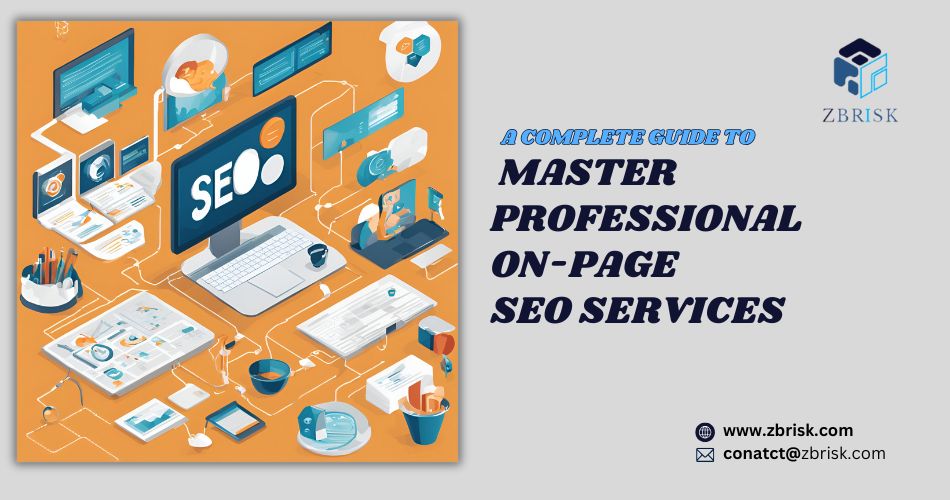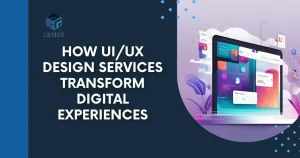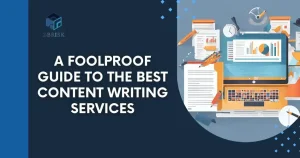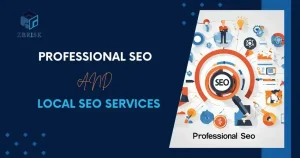Introduction to On-Page SEO
On-page SEO is a process of directly optimizing elements of every web page. It helps search engines to understand your page better and attract more traffic and higher rank. On-page SEO is also the most important aspect of digital marketing and SEO. It serves as the foundation for any successful online business. This comprehensive guide will walk you through everything you need to know about on-page and mastering professional on-page SEO services from the basic concept to the advanced. Unlike off-page SEO which focuses on external signals, on-page SEO gives you direct control over your website optimization elements.
Understanding On-Page SEO Fundamentals
On-page SEO fundamentals involve how to optimize each page of a website. What are the key factors to take care of on-page SEO?
Before that, we need to know the role of search engines in it. How do they work?
The Role of Search Engines
It is crucial to understand how search engine algorithms work for effective on-page optimization.
Search engines like Google have complex algorithms that first crawl, index, and then rank web pages.
The diagram shows how search engines work.
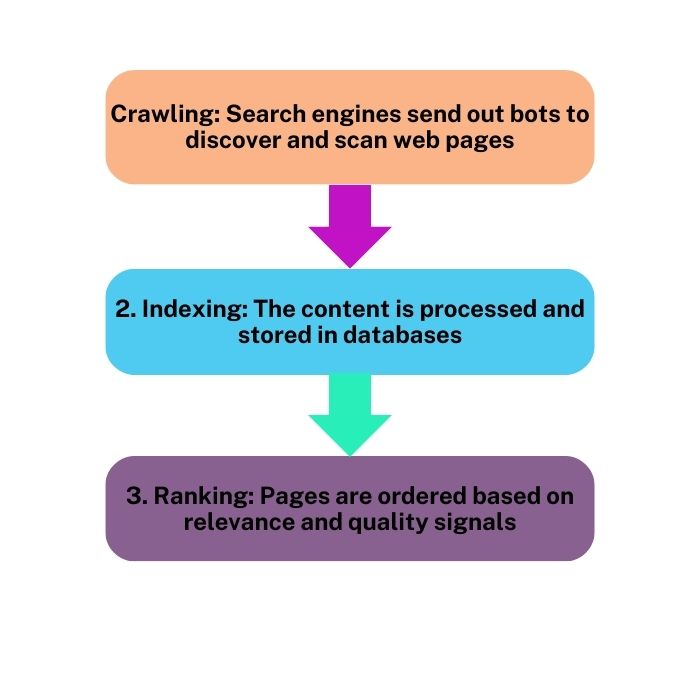
Why On-Page SEO Matters?
- Direct control over optimization elements
- Immediate impact on search visibility
- Cost-effective marketing strategy
- Foundation for other SEO efforts
- Better user experience
Essential Components of Effective On-Page SEO Optimization
These are critical On-page SEO components that act as a backbone of a successful on-page.
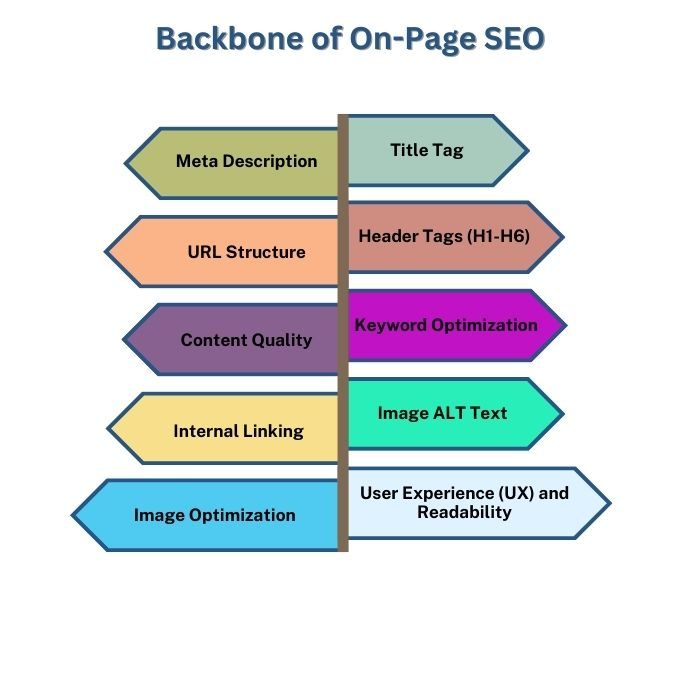
Title Tag
The title tag is the most important element of on-page SEO. Whenever a user enters a query in Google or any search engine the first thing against that query that appears on your website is the title. The web page title and content matching that query will be shown to the user.
Your web page “title” should be perfectly optimized. Best practices include:
- Keep title length between 50 to 60 characters or 580 to 600 pixels
- Include the primary keyword near the beginning
- Make each title unique and descriptive
- Include brand name when relevant
- Use compelling words that encourage clicks
Meta Descriptions
Beneath the title, a summary line of web page content appears called Meta description. This gives a preview of web page content before clicking it. While meta descriptions don’t directly impact rankings, a relevant, compelling meta description can significantly boost the visibility and effectiveness of a page in search results.
Factors to complete for effective description include:
- The optimal length of a Meta description is 150-160 characters or up to 920 pixels
- Include primary and secondary keywords naturally
- Write compelling copy that matches the search intent
- Include a call to action when appropriate
- Make each description unique
Header Tags (H1-H6)
Header tags are HTML elements used to define headings and subheadings on a web page. They play a key role in structuring content for both readers and search engines, making it easier to navigate and understand.
Types and Uses of Header Tags:
- H1 Tag: Used for the main title of the page, summarizing the page’s primary topic. There should only be one H1 per page.
- H2 Tags: Used for main sections or subtopics within the content. They help break down the information into digestible parts.
- H3, H4, and Lower-Level Tags: Used for sub-sections within H2 sections and to create a hierarchical structure, making content more organized.
Header tags improve readability by making content easy to scan, support SEO by helping search engines understand page structure, and enhance accessibility for users.
URL Structure
Clean, optimized URLs improve SEO by making it easier for search engines and users to understand the content and structure of a page.
- Keep URLs short and descriptive
- Use primary keywords where relevant
- Avoid unnecessary parameters
- Use hyphens to separate words
- Maintain a consistent URL structure
Keyword Optimization
Keyword optimization refers to the process of optimizing the web page using your targeting keywords by strategically placing them throughout the page. It includes your primary and secondary keywords that match user intent and place them into the key areas of the web page. It will increase the traffic, and boost the visibility and your web page ranking.
Places where you have to embed your targeting keyword are mentioned in detail in this blog.
Content Quality
Content is a King and It plays a crucial role in SEO. Valuable, relevant, and engaging content that meets the needs of your audience is called quality content. Quality content involves relevancy, detailed, readable, original, and accurate content. Well-optimized content will improve search engine ranking and build trust with both users and search engines.
Image ALT Text
A short description is added to the image’s HTML tag that tells the context of the image content. By reading these alt text search engines understand the image and ultimately improve your ranking. Image alt text helps visually impaired users who rely on screen readers to understand the content of the image.
Internal Linking
Internal is also an essential part of website structure and professional on-page SEO services. The process of linking one page of the website to another page of the same website is called internal linking. Internal linking plays a crucial role in enhancing the user experience, better site navigation, and boosting SEO performance.
A well-organized and structured website helps guide both users and search engines through the content. Key benefits include:
- Improved Navigation:
Internal links help users find related content, enhancing their experience on the site.
- SEO Boost:
Search engines use internal links to crawl a site and understand the relationship between pages. This can improve the rankings of linked pages.
- Distribute Link Equity:
Internal links help spread page authority across your website, boosting the SEO potential of other pages.
- Reduced Bounce Rate:
By linking to relevant content, you encourage users to explore more pages, reducing the likelihood of leaving your site quickly.
Image Optimization
Image optimization is about preparing images on your website so they help with SEO and provide a better experience for users.
Here are a few simple ways to optimize images:
- Use Alt Text:
Alt text is a short description of the image. It helps search engines understand what the image is about, which can improve your SEO. For example, if your image is of a “sunset over the mountains,” use that description as the alt text.
- Right Size and Format:
Large images can slow down your website, which might make visitors leave. To avoid this, resize images to fit well on the page, and choose formats that balance quality with size. Common formats are JPEG (smaller files, good quality) and PNG (higher quality, larger files). But for most cases, JPEG is a good balance between quality and load speed, while WebP is optimal if you want the best speed with high quality.
- Compress Images:
Reducing the file size of images (compressing) keeps them looking clear while loading quickly. There are a lot of free tools that’ll do this job for you.
- Use Descriptive File Names:
Use clear words to name your images, like “Effective SEO factors.jpg” instead of something generic like “IMG_4467.jpg.” This makes it easier for search engines to understand what’s in the image.
User Experience (UX) and Readability
One of the most important elements of effective and professional On-page SEO services is User experience and readability.
User experience refers to the experience of visitors or people who visit your website. People will have a good experience if they easily find and navigate what they seek. If your website is well organized and structured, contains quality content, and has buttons and links that are easy to spot, then users will have a smoother experience. Ultimately visitors will become happy and stay longer which is good for your site’s ranking.
Readability refers to the content on your webpage, which means it is easy to read for visitors. To make your content readable use simple words that visitors can easily understand and use short sentences. Divide content into sections with clear headings so that visitors will easily digest it. Use bullet points, lists images, and extra space around text to make it easier to follow. When your content is easy to read, visitors enjoy it more and stay longer.
Take Your Website to the Next Level with Zbrisk
After SEO keyword research for your niche, the next step is to do On-Page SEO of your website. Your website needs to be perfectly optimized to improve your website SEO. It will help you to attract the right audience, keep them engaged and obviously rank in search results. By applying all these above-mentioned on-page SEO strategies, you’re setting up your website for success and growth.
If you are here then you have already taken the first step, your next step to success is just a click away. Zbrisk is here to help you with professional SEO services. Drop your website link now for FREE WEBSITE AUDIT. This audit is a full check-up of your site’s current SEO performance. It will uncover any gaps and suggest easy ways to strengthen your SEO game and improve your rankings.
We are dedicated to delivering effective and professional SEO strategies tailored to your needs.
At Zbrisk, we believe that every website has unique potential. Our team will guide you through the process and provide customized recommendations to help your site perform at its best.
Don’t miss this chance to unlock your website’s potential
Contact Zbrisk today to claim your free SEO audit and see how we can help your site achieve more!

